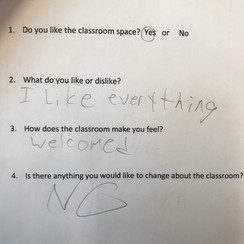Making Students Feel Safe In the Classroom
- mbickhaus
- Nov 5, 2018
- 4 min read
“It makes me feel safe,” she said. And I could have wept.
When I asked the students what they liked about my room, one student responded with, “I feel welcome. It makes me feel safe.” This thirty-second exchange let me know that the classroom had made a difference. It affirmed that all of the thinking, planning, and creating had achieved the most important effect.
Safe. Not just safe but it made her “feel safe.” In the trauma-informed and trauma-sensitive realm, “felt safety” is the zenith!
Children who suffer from the effects of complex trauma do not experience the same sense of comfort and ease in surroundings as those who have had the good fortune to enjoy a simpler or less stressful upbringing. Instead they are almost always guarded and hypervigilant. They respond to typical classroom and school events as though they are in danger. Their bodies are frequently in the fight, flight, or freeze mode. Because of their disrupted brain development, their bodies are constantly fooled into reacting as though they are in a traumatic or dangerous situation. Their brains hijack their bodies and the students are helpless to control these reactions.
With this in mind, I set about this past August to create a classroom environment that would mitigate this perpetual feeling of danger many of our students experience.
I assessed my classroom and began thinking of it in terms of a spa, baby nursery, and living room instead of a typical classroom. I looked at every space through the lens of a mother as well as a spa owner who wants to draw and retain the most particular client.
Students in my school setting frequently respond with “flight”. We call it AWOL. They leave the classroom, often for no discernible reason. Of course, the reason is the whacky way their neurons are firing which makes them believe they are in peril.
Sometimes students react with a “freeze” response. They shut down. One student might put his head down on the desk and even fall asleep. Another student might stare straight ahead and refuse to engage in dialogue. This is the body’s way of protecting itself as it responds to the belief that it is in danger.
The “fight” response is just as one would expect. A student will make a rude comment, make a threat, and/or perhaps even become physically aggressive. To the unwitting observer it would seem as though these reactions appear from out of the blue, but my colleagues and I recognize that they are responding to past trauma.
The traditional classroom just does not meet the needs of students who suffer from the recurring effects of trauma. We must examine our concepts of what a classroom is and should be. We need to ask why we continue to create school environments which have changed very little over the decades. We should respond to what the research tells us about students who suffer from a number of disorders owing to complex trauma and adjust not only our teaching methods but the very environment in which the students spend the best hours of their days.
My response to what I’ve learned about the hardest cases and how the research applies to these students was to recreate my classroom. I considered every sensory aspect and sought to establish a safe haven for my students; a sanctuary, if you will. A space where they felt safe enough to let down their guard and allow their brains to become more accessible to the higher level activity necessary for academic progress.
I minimized visual distractions. I softened any hard surfaces. I provided varied tactile experiences for seating and allowed for freedom of choice in seating. I looked at every little corner and fashioned the softest and most comforting areas which would still allow for exploration and the opportunity to capitalize on their intellectual curiosity. I took photographs of the space and refined the areas based on assessment of those photos in addition to sitting in the spaces and assessing the “feel” of the areas.
Please take a look at the video of my classroom and notice the following:
*Visibility of all areas of the classroom is maintained - no hidden corners
*Separate, small areas where students can seek solitude and peace in order to practice self-regulation yet still maintain visibility to staff
*Bulletin board areas are turned so they are not the visual focus of the room in order to minimize stimuli
*Soft lighting through the use of lamps, string lights, and a dimmer on overhead lights
*Living room environment is conducive to small group academic and relational work
*Coziness is created and spaces are defined through the use of rugs as well as cubes
*Students take pride in maintaining the high quality environment through shared duties in routine, daily cleaning
The result is a classroom which feels more like a living room. It’s a comforting haven in which students feel at home. In fact, many students come from homes in which they do not feel safe yet they long for the security of a stable home in which they feel safe. Here they can enjoy that sense of a home-like retreat.
It’s a refuge in which students feel safe. They don’t feel as though they have to watch their backs every moment. They can relax. They can begin to allow relationships to form and they can access areas of their brains required for critical thinking.
“The ache for home lives in all of us. The safe place where we can go as we are and not be questioned.”
― Maya Angelou, All God's Children Need Traveling Shoes



















Comments